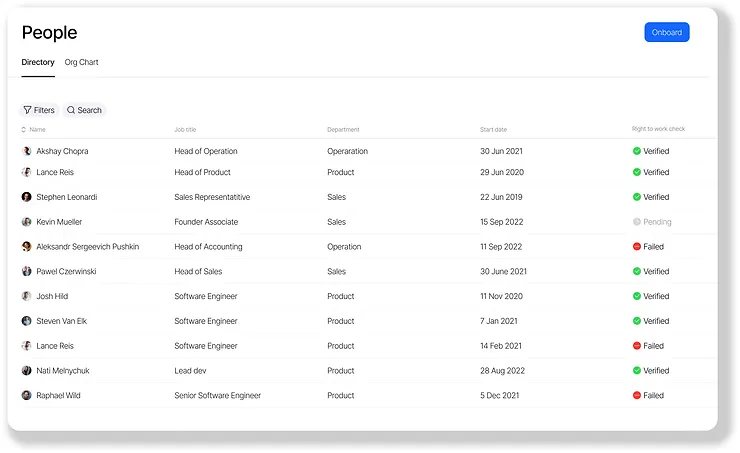Employers guide to right to work checks
Any employer needs to check whether a person has the right to work in the UK. This has been the case for a long time, however with the recent change in legislation which came into force in October 2022 employers need to adapt their processes to remain compliant.

By doing simple right to work checks, an employer can make sure a potential employee satisfies the current immigration and employment laws.
If you cannot show evidence that you checked an employee’s
right to work in the UK you can be fined up to £20,000.
Employers should follow the government guidance so that they are able to claim a statutory excuse against any potential liability (e.g. if it turns out that the employee did not actually have the right to work in the UK)
The law is changed in October 1, 2022
Since 1st October 2022, employers need to perform identity checks on potential candidates either by meeting them face-to-face or by using ID validation technology to verify hiring documents. It is recommended that businesses use government-certified Identity Service Providers (IDSPs) as it is likely ID validation technology will become mandatory soon. Read more about the change here.
Below you can find a list of all government-certified IDSP.
Who needs to be checked for right to work?
An employer must check any potential employee according to the government guidelines which can be checked on the gov.uk website.
Types of right to work check
As said above, an employer must ensure any person she employs is allowed to work and that their immigration status does not disqualify them from working in the UK. There are two main ways that an employer can carry out a right to work check:
- Manual check (document based)
- Online check
If an employee or potential employee can’t show their documentations or can’t share their immigration status online, an employer can use the Employer Checking Service.
Right to work checklist
An employer needs to:
- Check the employee’s documents from List A or List B under Annex A available at the following link
- Check whether any permission to be in the UK has not expired (e.g. visa)
- Check for any work restriction to make sure the (potential) employee is allowed to carry out the job (e.g. students during term-times may not be allowed to work)
- Check the authenticity of the documents and make sure that the person in the document is the employee. Make sure data is consistent across certificates (e.g. last name) and that any difference can be explained with supporting documents. For example, a name change due to marriage can be supported with an original marriage certificate.
- Keep a copy of all documents and supporting documents for all the employment duration as well as for an additional 2 years after the termination of the contract. Having a copy will serve the employer in the case she is required to prove she has conducted a right to work check. In this way, she will retain a statutory excuse. Such documents should contain a date declaration stating when the check was carried out as well as they should be in a format that can’t be manually altered (e.g. png, jpeg, pdf). The employer can also keep a hard copy of the documents. If the employer fails to note the date stating when the check was conducted, she may get a civil penalty.
How to carry out an online right to work check
If an employee did not have the right to work and the employer did not properly conduct a right to work check they could be liable for a penalty as high as £20,000. The best way to carry out a right to work check is online.
The employee needs to share a code that the employer can check at the following link.
Employers should bear in mind that not all immigration statuses can be checked online. At the moment, the online service can be used for those candidates holding:
- Biometric residence card (BRC)
- Biometric residence permit (BRP)
- British National Overseas (BNO) visa
- EU Settlement Scheme application certificate created on or before 30 June 2021
- Frontier workers permit (FWP)
- Status issued under the points-based immigration system (e.g. having a certificate of sponsorship)
- Status issued under the EU Settlement Scheme
Employers can’t force employees to use the online right to work check. However, online right to work checks using share codes have become popular. If the documents that the employee provides are from the accepted list of documents (i.e. List A, List B under Annex A), the employer must perform a manual check.
How to automate background checks during onboarding
The new requirements mean that your processes need to be come more digital and opting for an employee platform like Zelt can help streamline this process.

We’ve partnered with Zinc to help people teams supercharge their onboarding process by automating background checks, saving valuable time and improving employee experience.
Follow up checks
Employers should conduct follow up checks in the same way outlined above for all those employees whose work permit is time-limited. These employees will be the ones that provided documents from List B in Annex A.
- Group 1 documents offer a statutory excuse with a time limit which ends when the person’s work permission does
- Group 2 documents offer a statutory justification which ends six months after the date noted in their Positive Verification Notice
Changes to work checks for biometric residence permit holders
From 6 April 2022, manual check should not be carried on the the physical biometric card. BRC, BRP and FWP are no longer on the list of acceptable documents used to carry out a manual check. The check will no longer be law-abiding if the employer does not use the online method and the employer will not have a statutory excuse from civil penalty. However, there will be no need to conduct checks on employees who used their physical BRP to prove their right to work in the UK before the 6 April 2022.


